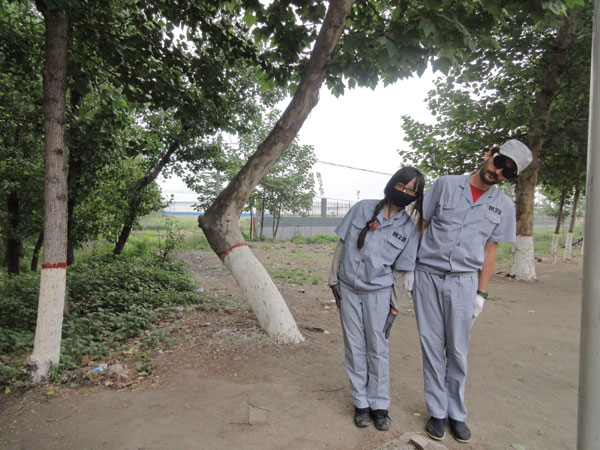The ride of his life
Updated: 2012-06-05 07:48
By Yang Yijun (China Daily)
|
|||||||||||
|
Artist Niko de la Faye travels with Shi Yang, a graduate from the Central Academy of Fine Arts, from Beijing to Shanghai to transfer the sculpture M2B. Provided to China Daily |
"M2B was created to be a 'poetical interference'. The whole structure is a representation of the universe."
The sculpture is a cubic stainless steel structure, based on the yin-and-yang symbol. Eight black and white balls representing bagua, or trigrams from Taoist cosmology, are installed in the eight corners of the sculpture.
Spheres, prisms and cubes in red, yellow and blue are set inside the cubic structure, representing the elementary particles that make up the universe.
"When the tricycle is moving, it animates the whole system due to the belts connected to the wheel," he says, explaining that M2B means "from MUKS (Mobile Urban Kinetic Sculpture) to BEKS (Butterfly Effect Kinetic Sculpture)".
When he arrived in Shanghai on the evening of May 29, he displayed M2B at the intersection of Fenyang Road and Taiyuan Road in the former French Concession, inspiring considerable interest.
"That's what happens," de la Faye says. "There are so many different reactions to it: Some people look up. Some people look down. Some smile. Some are just surprised."
He recalls that in Jinan, the provincial capital of Shandong province, a doctor looked at the sculpture and immediately recognized that it represented the universe.
"In contrast, in a small county in the province, an old lady passed by and said, 'Hello! Are you selling vegetables?' That was the most interesting reaction we had," he says.
De la Faye traveled with Shi Yang, a 25-year-old graduate from the Central Academy of Fine Arts. They both wore gray suits with a M2B logo and took just two small suitcases with them.
"She brought a lot of good things to this project because she is Chinese, a sculptor, and is young and creative," he comments.
The only hiccup on the trip, he says, was a problem with the brakes.
"We often stayed at youth hostels and ate in small restaurants. In some cities, hotels were unwilling to host a foreigner. And in tiny villages where no hotel could be found, we had to knock on the doors of local residents," Shi says.
In cities and villages where they stopped, they unpacked a white screen and turned a light on the sculpture at night.
"The effect was similar to traditional Chinese shadow plays. The show received a lot of interactions in many cities, especially in Jinan and Nanjing, " De la Faye says.
In small villages, he says, people looked at the work as a piece of machinery, whereas in the cities most people viewed it as art.
He says his work is based on illusion but is transformed when it comes into contact with people.
"Many people are not into galleries or museums. I like to take my work on trips because that's where people are."
Contact the writer at yangyijun@chinadaily.com.cn.
Today's Top News
Rescuers race against time for quake victims
Telecom workers restore links
Coal mine blast kills 18 in Jilin
Intl scholarship puts China on the map
More bird flu patients discharged
Gold loses sheen, but still a safe bet
US 'turns blind eye to human rights'
Telecom workers restore links
Hot Topics
Lunar probe , China growth forecasts, Emission rules get tougher, China seen through 'colored lens', International board,
Editor's Picks

|

|

|

|

|

|






